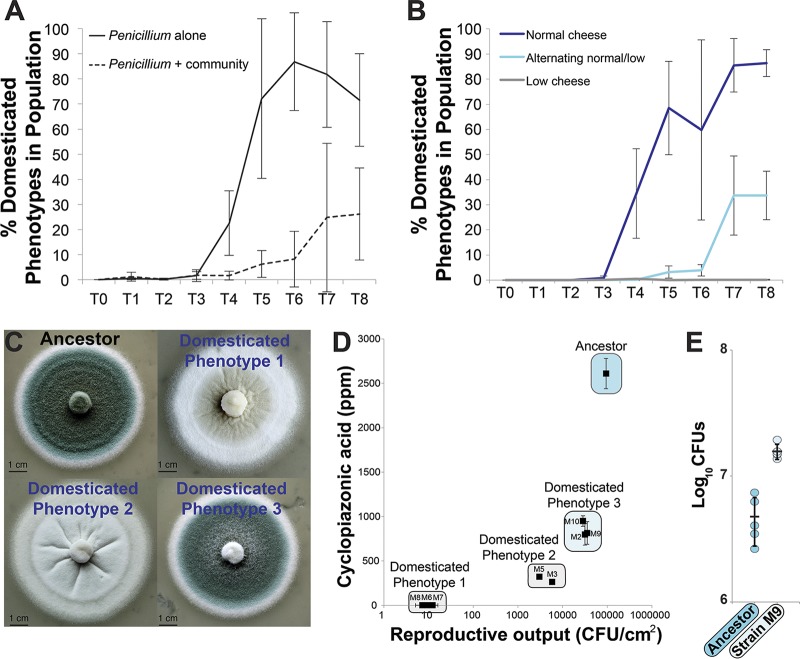FIG 2.
Experimental evolution of Penicillium on cheese. (A) Evolution of Penicillium commune strain 162_3FA on cheese curd alone (“Penicillium alone”) and in the presence of three competing cheese rind microbes (“Penicillium + community”; Staphylococcus xylosus, Brachybacterium alimentarium, and Debaryomyces hansenii). Lines connect points representing mean domesticated phenotype frequencies of four replicate populations, and error bars represent 1 standard deviation of the mean. “Penicillium + community” had a significantly lower domesticated phenotype frequency (repeated-measures ANOVA; see text for statistics). (B) Experimental evolution of P. commune strain 162_3FA in different cheese nutrient environments. “Normal cheese” = 10% cheese curd in agar medium. “Low cheese” = 1% cheese curd in agar medium. “Alternating normal/low” = alternating 10% and 1% cheese curd at each transfer. Both “Low cheese” and “Alternating normal/low” had significantly lower domesticated phenotype frequencies (repeated-measures ANOVA with Tukey’s HSD post hoc tests; see text for statistics). Lines connect points representing mean domesticated phenotype frequencies of four replicate populations, and error bars represent 1 standard deviation of the mean. The “low cheese” line is difficult to see because it is at 0%. (C) Morphology of four representative colony types. The ancestor phenotype was dark blue-green and dusty; domesticated phenotype 1 was white and flat; domesticated phenotype 2 was white and fuzzy/dusty; domesticated phenotype 3 was blue-green but had less intense coloration than the ancestor and a less fuzzy appearance. (D) Reproductive output and cyclopiazonic acid production of a range of strains isolated across the experimental evolution populations. Points are mean values, and error bars represent 1 standard deviation of the mean. Strains M5, M6, M7, and M8 had reduced reproductive compared to the ancestor (Dunnett’s test, P < 0.05). All domesticated phenotypes had significantly reduced CPA production compared to the ancestor (Dunnett’s test, P < 0.05). (E) Competition between ancestral P. commune strain 162_3FA and domesticated strain M9. Strain M9 outcompeted the ancestor after 10 days of growth on cheese curd agar. Points represent individual replicate competition communities, and the horizontal line indicates mean values. Error bars represent 1 standard deviation.

